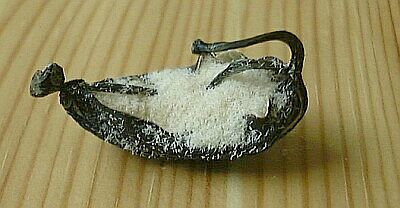Biology of orchid seed germination
Orchid seeds are very small (like dust) and do not contain any food reserves which feed the embryo in his first steps of life like other plants do (e.g. apple, beans). Because of this fact, orchids produce a high number of seeds (up to 1 millon in each capsule).

In nature, when a seed land on a wet piece of bark, the embryo swell a little bit but it will not form a seedling unless it gets infected by a symbiotic fungus (mycorrhizal fungus) which supplies the embryo with sugar and nutrients. As soon as the symbiosis is established, the embryo becomes a little "ball", which is called protocorm. These protocorms turn green after a while and the first leaf and roots appear. From this stage the seedlings can live without the symbiotic fungus because the photosynthesis is active.


We have germinated seeds of Epidendrum radicans which build green protocorms after 2 weeks. Cyrtopodium punctatum protocorm took for the same stage more than 2 months.

protocorms with first leaves

protocorms with first leaves
Symbiotic germination in the pot of the parents
This technique was mainly used before in-vitro culture intruduced in plant propagation. Dry seeds get sown close to the roots of orchids at flowering size because there the chance is high that the right symbiotic fungus is present. The number of seedlings is limited because many protocorms and seedlings get killed by pests and aggressive fungi. This method was very successfully used in the early 20th century by Mr. Hefka, who was the responsible gardener for orchids in Schönbrunn (Vienna), and also by Dr. Burgeff.

Symbiotic germination (in vitro)
To use this technique we have to isolate the symbiotic fungus from a root of the orchid where the capsule was produced. The fungus has to be established on a media with a very low concentration of nutrients (e.g. oat meal agar). Next we have to sterilize the orchid seeds and sow them on the media which contains the isolated fungus. The seeds will germinate and produce seedlings if the isolated fungus is compatible with the seeds. If not, no germination will take place.
With this methode it is possible to rise much more plants from the same quantity of seeds as we can do with "Symbiotic germination in the pot of the parents".

Asymbiotic germination (in vitro)
To avoid the high effort, which is needed to isolate and test the fungus, we can "simply" ignore the fungus and add all necessary nutrients (which are provided by the fungus) to the media. The only thing we have to do is to cook the media and sow the seeds under sterile conditions on this media. For more details please read asymbiotic seed germination.
Author: Thomas Ederer
